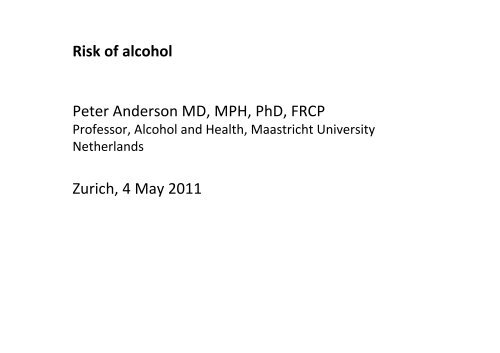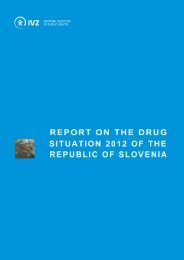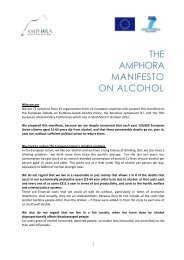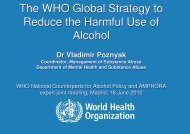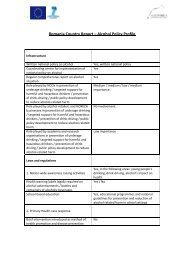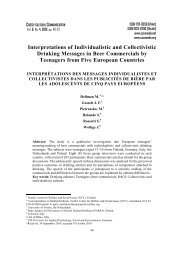Risk of alcohol Peter Anderson MD, MPH, PhD, FRCP Zurich, 4 May ...
Risk of alcohol Peter Anderson MD, MPH, PhD, FRCP Zurich, 4 May ...
Risk of alcohol Peter Anderson MD, MPH, PhD, FRCP Zurich, 4 May ...
Create successful ePaper yourself
Turn your PDF publications into a flip-book with our unique Google optimized e-Paper software.
<strong>Risk</strong> <strong>of</strong> <strong>alcohol</strong><br />
<strong>Peter</strong> <strong>Anderson</strong> <strong>MD</strong>, <strong>MPH</strong>, <strong>PhD</strong>, <strong>FRCP</strong><br />
Pr<strong>of</strong>essor, Alcohol and Health, Maastricht University<br />
Netherlands<br />
<strong>Zurich</strong>, 4 <strong>May</strong> 2011
Lifetime risk <strong>of</strong> an <strong>alcohol</strong>related<br />
death (1/100)<br />
16.0<br />
14.0<br />
12.0<br />
10.0<br />
8.0<br />
6.0<br />
4.0<br />
2.0<br />
0.0<br />
Men daily<br />
Women daily<br />
Men weekly<br />
Women weekly<br />
10 20 30 40 50 60 70 80<br />
Grams <strong>alcohol</strong> per day or per week<br />
Lifetime risk <strong>of</strong> dying from <strong>alcohol</strong>-related death by gram<br />
<strong>alcohol</strong>/day or /week for Australian men and women.<br />
Source: National Health and Medical Research Council, Australia, 2009
How can this be?<br />
Is it really the case that the risks for<br />
men and women are the same?
1. How are the estimates made<br />
2. What about heart disease?<br />
3. What do the risk curves mean?
1. How are the estimates made<br />
2. What about heart disease?<br />
3. What do the risk curves mean?
Let us first look at non-injury<br />
<strong>alcohol</strong>-related diseases
For each <strong>of</strong> the 10 consumption<br />
categories, need to work out life<br />
time risk <strong>of</strong> a death caused by<br />
<strong>alcohol</strong>
To do this, first, take the population<br />
(in this case Australian), and divide<br />
into men and women and 6 age<br />
groups, 15-29, 30-44, 45-59, 60-69,<br />
70-79 and 80+ years.
For each gender and age group,<br />
calculate, from death certificates,<br />
annual mortality rates for the<br />
specified diseases, multiplied by the<br />
number <strong>of</strong> years in the age group.<br />
For example, for women aged 30-44,<br />
their one year risk is multiplied by<br />
15, as they are in this category for 15<br />
years.
From this, then work out the<br />
proportion <strong>of</strong> deaths (and thus death<br />
rates) due to <strong>alcohol</strong> for each <strong>of</strong> the<br />
10 drinking categories
Did this by getting the relative risks<br />
for the diseases under question for<br />
each <strong>of</strong> the consumption categories<br />
compared with no consumption<br />
from published meta-analyses. Here<br />
they are:
From this, can calculate <strong>alcohol</strong><br />
attributable fractions (AAF), using<br />
the formula:<br />
Where:<br />
i: level <strong>of</strong> drinking (i.e. 10g pure <strong>alcohol</strong> per day…. 100g<br />
pure <strong>alcohol</strong> per day)<br />
P: prevalence <strong>of</strong> <strong>alcohol</strong> consumption in the drinking<br />
category.<br />
RRi: relative risk for drinking level i<br />
Here are the AAFs:
Then, for each total mortality rate,<br />
multiply the total mortality rate by<br />
the AAF to give the <strong>alcohol</strong> mortality<br />
rate.
Then, add up the risks over diseases<br />
and age groups to give lifetime risk<br />
by consumption category. Here is<br />
the graph again.
The method <strong>of</strong> injury deaths is<br />
similar, but a little more<br />
complicated, as it needs to account<br />
for both the number <strong>of</strong> drinking<br />
occasions and the amount drunk per<br />
occasion, as well as the risk period<br />
(the time that <strong>alcohol</strong> remains in the<br />
body after a drinking occasion and<br />
thus increases risk <strong>of</strong> injury).
First, take Alcohol Attributable<br />
Fractions (AAF) by age group for<br />
injuries from an Australian study.<br />
Here they are:
Next, calculate the baseline rate for<br />
injury death without <strong>alcohol</strong>, being<br />
the total death rate minus (the total<br />
death rate times the AAF).
The Relative <strong>Risk</strong>s for injury<br />
following a drinking occasion by<br />
<strong>alcohol</strong> consumption were obtained<br />
from a WHO 10 country study <strong>of</strong><br />
emergency departments. Here they<br />
are:
For each amount per occasion,<br />
combine the baseline risk with the<br />
<strong>alcohol</strong>-based relative risk for one<br />
occasion to give the absolute risk <strong>of</strong><br />
injury death per one drinking<br />
occasion related to consumption<br />
categories.
And, then multiply by the number <strong>of</strong><br />
lifetime drinking occasions, ranging<br />
from 50 to 20,000, corresponding<br />
from a range <strong>of</strong> one drinking<br />
occasion per year to one drinking<br />
occasion per day.
Of course, need to adjust for the<br />
period <strong>of</strong> risk resulting form a<br />
drinking occasion. This period relates<br />
to the time that <strong>alcohol</strong> is in the<br />
blood, not the whole 24 hours <strong>of</strong><br />
day.
For example, <strong>alcohol</strong> in blood 3<br />
hours after an intake <strong>of</strong> 50g – thus,<br />
the risk period is 3 hours, not 24<br />
hours.
Probabilities <strong>of</strong> death are then computed<br />
for each age, gender, injury, and<br />
consumption group (e.g. the lifetime<br />
probability <strong>of</strong> an <strong>alcohol</strong>-attributable<br />
motor vehicle death for 20–29 year old<br />
men who drank approximately 20g<br />
<strong>alcohol</strong> 4 times per week), and added up<br />
across injury categories and ages. Here<br />
are the graphs again:
1. How are the estimates made<br />
2. What about heart disease?<br />
3. What do the risk curves mean?
Whether or not <strong>alcohol</strong> reduces the<br />
risk <strong>of</strong> ischaemic heart disease (and<br />
ischaemic stroke) does not change<br />
the absolute risks <strong>of</strong> the deaths due<br />
to <strong>alcohol</strong>, which are due to adverse<br />
events.
In any case, most <strong>of</strong> the protective<br />
effect <strong>of</strong> <strong>alcohol</strong> on heart disease<br />
can be achieved at 5g <strong>alcohol</strong>/day,<br />
lower than any likely guidelines for<br />
lower risk drinking.
Any protective effect disappears<br />
when light drinkers report at least<br />
just one heavy drinking occasion per<br />
month.
And, a protective effect is based on a<br />
different conceptual framework<br />
from an adverse effect, since more<br />
protection can be achieved by<br />
engaging in other healthier<br />
behaviours (e.g., healthy diet, more<br />
physical activity), which incur no<br />
added risk.
1. How are the estimates made<br />
2. What about heart disease?<br />
3. What do the risk curves mean?
Lifetime risk <strong>of</strong> an <strong>alcohol</strong>related<br />
death (1/100)<br />
16.0<br />
14.0<br />
12.0<br />
10.0<br />
8.0<br />
6.0<br />
4.0<br />
2.0<br />
0.0<br />
Men daily<br />
Women daily<br />
Men weekly<br />
Women weekly<br />
10 20 30 40 50 60 70 80<br />
Grams <strong>alcohol</strong> per day or per week<br />
Lifetime risk <strong>of</strong> dying from <strong>alcohol</strong>-related death by gram<br />
<strong>alcohol</strong>/day or /week for Australian men and women.<br />
Source: National Health and Medical Research Council, Australia, 2009
The exact slope <strong>of</strong> the curves is<br />
country specific as it depends on the<br />
prevalence and distribution <strong>of</strong> both<br />
diseases and drinking patterns in the<br />
population - but, for most EU<br />
countries, at least, they will be<br />
similar to the Australian curves.
At 20g/day, the lifetime risk that<br />
death is due to <strong>alcohol</strong> is less than<br />
1:100 for both men and women.
At 60g/day, the lifetime risk that<br />
death is due to <strong>alcohol</strong> is just under<br />
1:10 for both men and women.
How do the risks compare with other<br />
risks?
Well, they are high.
In terms <strong>of</strong> drinking water, WHO sets<br />
a general upper guideline at the<br />
concentration which would give rise<br />
to a risk <strong>of</strong> 1 additional cancer per<br />
100,000 people on a lifetime basis.<br />
A study <strong>of</strong> regulation <strong>of</strong> risky<br />
substances in Canada and US sets<br />
thresholds at 1:22,00 and 1:10,000.
Asbestos exposure is estimated to<br />
pose a lifetime mortality risk <strong>of</strong><br />
between 1:1,000 and 1:10,000.<br />
Eating pesticide grown fruit is<br />
estimated to pose a lifetime<br />
mortality risk <strong>of</strong> 1:22,000.
The data also suggests that we<br />
should talk in terms <strong>of</strong> risk, and not<br />
use terms like safe drinking, sensible<br />
drinking, <strong>alcohol</strong> misuse etc,<br />
because these terms do not mean<br />
anything.<br />
And, we need to get the risk<br />
message across - too many people<br />
still think that <strong>alcohol</strong> is good for<br />
you.
And, finally, this is at the individual<br />
level – we will deal with the<br />
population level tomorrow morning.


